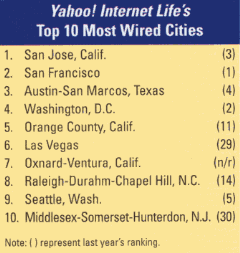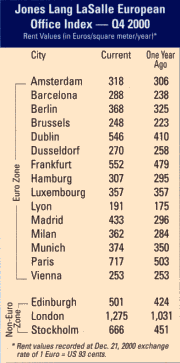ranking of the most wired cities, knocking San Francisco to the No. 2 spot.
D |
espite all of the hullabaloo about the energy scare and lack of labor, U.S. DataPort chose to locate a US$1.2 billion, 1,100-job Internet campus in Silicon Valley — one of the nation’s largest multidata centers. But for such an energy- and labor-intensive operation, one must question why San Jose?
The answer is simple. It’s not what San Jose lacks as much as what it has to offer. “The San Jose site is strategically located with access to high-capacity fiber networks, an exceptional labor force and major transportation corridors,” says Grant Sedgwick, president and CEO of U.S. DataPort. As for the energy issue, that’s being handled by an onsite energy-generation facility.
U.S. Dataport’s announcement is proof that California is still tops in many areas, especially technology-related issues. In fact, Yahoo! Internet Life (www.yil.com) magazine’s fourth annual ranking of “Most Wired Cities” ranked four California cities in the top 10 (see accompanying chart for YIL‘s 10 Most Wired Cities).
San Jose knocked San Francisco out of the No. 1 spot this time around, but the City by the Bay managed to hold on to second place. Orange County moved up six to No. 6, and Oxnard-Ventura debuted this year at No. 7.
“California dominates because Pacific Bell has been so effective in offering fast DSL access to its customers,” says Don Willmott, technology editor with YIL. “California was out front in fast access to the home, and that’s reflected in many of the stats that go into our calculations.”
California cities made up the top three markets in terms of broadband use or strong interest in using broadband. Oxnard-Ventura, Bakersfield, and Stockton-Lodi, Calif., had 63, 61 and 57 percent of households using broadband or expressing interest. San Jose took the No. 5 spot in this category, while Sacramento tied Oklahoma City, Okla., and Fort Worth-Arlington, Texas, for No. 8, with 52 percent of households using or interested in broadband.
‘Most Wired’ Research Methods

YIL ranked the most wired cities based on four measurements: how many of the city’s residents use the Internet, how sophisticated are the residents, how many of the city’s businesses are on the Internet, and how much content about the city and its government is available online. Cambridge, Mass.-based Forrester Research, a respected technology research firm, provided YIL with the percentage of households online, the proportion of households connected to the Internet through broadband (or at least have expressed strong interest in it), and the average household expenditure online over a three-month period.
In addition to California’s stronghold on the broadband usage category, it also topped the online spending category. San Jose, Calif., was No. 1, with an average expenditure of $297 per Internet user over three months; second-place San Francisco rang up $211 in online spending per Internet user. The most households online award, however, goes to Austin-San Marcos, Texas, with 70 percent of households being online. San Jose came in a close second with 68 percent of households online.
YIL turned to the Dept. of City and Regional Planning at the University of California at Berkeley as the source for business use on the Net. The department’s Matthew Zook conducts extensive analysis of the geographic distribution of Internet use and its relationship to local economies. The measurement used by YIL was the number of domains registered per thousand businesses in a city.
California again dominated, ranking seven of the top 10 cities. San Jose and San Francisco led the group with 3,487 and 3,240 domains per thousand businesses respectively. The rest of the top 10 cities for domains per thousand businesses include San Francisco; Los Angeles-Long Beach; Oakland, Calif.; Washington, D.C.; Orange County, Calif.; New York; Oxnard-Ventura, Calif.; San Diego; and Austin-San Marcos, Texas.
In an interesting turn of events, however, when YIL editors rated government sites, California fell prey to some of its East Coast counterparts. New York took the No. 1 spot, followed consecutively by Orange County, Calif.; San Francisco; and Washington, D.C.
Measurements and rankings such as YIL‘s wired cities are important to site seekers like U.S. DataPort. “Because the survey covers lifestyle, business and government, it suggests that the most wired cities have both general populations and elected offices who are somewhat Net-savvy and who appreciate what the Net can do,” explains Wilmott. “That means that companies looking to hire such people should look in these cities.”
Jones Lang LaSalle Records New Heights in European Office Activity |
Record levels of take-up in both Eastern and Western Europe office space led to equally impressive rental rates, according to Jones Lang LaSalle’s (JLL) Fourth Quarter 2000 European Office Index and its Central and Eastern European Office Index. The JLL reports are barometers of 18 major office markets in Western Europe and six office markets in Central and Eastern Europe. 
Western Europe 2000 was a record year for Western Europe, with occupiers taking more than 106.6 million sq. ft. (9.9 million sq. m.). Combined with a low level of spec development, the average European vacancy rate dropped to 3.1 percent — the lowest level since 1988. Rising rental rates and lack of space raised the Rental Rate Index 5.5 percent over the quarter and 22 percent during the year (see chart for current rental rates for the 18 metros studied by JLL). The Rental Rate Index represents the average rental change for prime property across the 18 Western markets from 1980 to December 2000. Rental growth in 2000 was strong in both core and peripheral prime markets, notes JLL. The fastest growth was recorded in Stockholm (48 percent), Madrid (46 percent), Paris (42 percent), Dublin (33 percent), London West-End (31 percent) and Milan (27 percent). Western Europe’s most active business sectors were technology, media and telecom (considered one sector by JLL) and the banking/finance/insurance business. Together the two industry sectors represent approximately 50 percent of the region’s leasing transactions in 2000. “In the German markets, demand from the TMTs was strong, but rental growth was more modest by comparison,” reports JLL. “On a year-on-year basis, prime rents rose in Frankfurt (15 percent), Berlin (13 percent), Munich (7 percent), Dusseldorf (5 percent) and Hamburg (4 percent).” Eastern Europe Leasing activity hit new highs in Central and Eastern Europe as well. Records were broken in Prague (1.9 million sq. ft./180,000 sq. m.), Warsaw (2.3 million sq. ft./225,000 sq. m.), Bucharest (710,900 sq. ft./66,000 sq. m.) and Moscow (3.6 million sq. ft./334,000 sq. m.). This level of take-up was driven by strong economic fundamentals, reports JLL. Regional economic growth was higher year-on-year for all six cities studied by JLL (Budapest, Warsaw, Prague, Bucharest, Kiev and Moscow), averaging 5 percent growth against the Eurozone’s 3.3 percent average, and GDP growth was at a five-year high. Forecasts show continued economic growth averaging 4.1 percent in 2001 and 3.7 percent in 2002 in Central Europe, and 4 percent and 1.9 percent respectively in Eastern Europe.  Rental rates continued to drop in 2000, but not at the pace set in 1999. Budapest’s prime rents dropped only 2.5 percent vs. the 11 percent drop recorded in 1999. Prague’s annual rate of decline slowed from -14 percent in 1999 to -2 percent in 2000. Warsaw saw rents fall 7 percent in the fourth quarter and 13 percent over the year. Kiev, too, experienced a decrease in prime rents, falling 9 percent over the quarter to a monthly rate of US$32 per square meter, but the first half of 2000 showed Kiev’s rental rates rise from $35 per square meter a month to $42 per square meter. The CEEOI suggests that “more high-quality product was introduced onto the market during 2000, and while vacancy rates in general remained above 10 percent, there is every prospect that these will be eroded in the face of increased demand from international occupiers.” |

